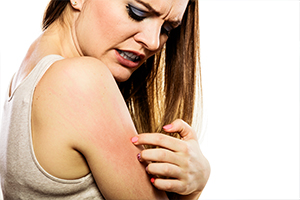
Temperatures are climbing this summer, and before we know it each day’s forecast will top 100 degrees. While we can’t do much about the temperature outside, our bodies have ways of keeping our internal temperatures regulated. The biggest organ in our bodies, our skin, may seem like simply a thing that keeps our skeletons in place, but it does much more than that. Our skin absorbs and shields us from all of the elements on planet Earth.
Therefore, when our skin has an issue, it’s a sign that something else may be going on. We’ve all been told to protect our skin from UV rays by using sunscreen—ideally 85 SPF or higher—but what about skin conditions beyond a standard sunburn? How do we know which conditions are mild, and which require a doctor?
Rashes
A rash is defined as an area of irritated or swollen skin. They are mostly red, itchy, painful and irritated easily. Some rashes come on very suddenly, and others may take a few days to develop. Some also disappear on their own, while others require medical intervention.
Contact dermatitis is a condition caused by the skin’s reaction to an irritating substance. Irritant dermatitis is a condition where the skin becomes irritated after contact with substances like acids, soaps, detergents, fabric softeners, solvents or other chemicals. Cement, hair dyes, pesticides, rubber gloves and even shampoo can cause the condition. Allergic contact dermatitis is a condition where a rash forms after the skin comes in contact with something that you’re allergic to. Common allergens are adhesives, antibiotics, certain fabrics, preservatives, and some heavy metals.
Poison Ivy
The irritant that actually causes a rash in poison ivy rashes is a substance called urushiol. Its oily residue is in the leaves, stems and roots of poison ivy plants. You can treat most cases of poison ivy at home with lotions and cool baths, but you may need stronger medications if the rash persists. Symptoms include redness, itching, swelling, and blisters at the rash site. The reaction typically develops 12 to 48 hours after initial contact with poison ivy. You can get poison ivy rashes by coming into direct contact with poison ivy, touching objects that have touched poison ivy (indirect contact) or inhaling smoke from burning poison ivy plants. The rash won’t spread, but you should see a physician if the reaction is widespread, symptoms do not go away after a week, or you have a fever greater than 100 degrees F.
Rashes in children
Small, simple rashes are common in children, typically harmless and clear up usually on their own. Bumpy skin, flat skin, red-colored skin and scaly skin are a few of the rash types that children develop. The most common type of rash that children get is diaper rash—simply caused by an irritation of the skin due to damp diapers against skin. Most babies who wear diapers will develop the rash. It’s often not serious and clears up quickly with over-the-counter medication.
Heat rashes and sun rashes
Some of the most uncomfortable skin conditions people experience during the summer months have to do with the skin’s reaction to outside temperatures and moisture levels. A heat rash specifically doesn’t just affect kids—it affects adults, especially during hot and humid weather.
A heat rash develops when blocked pores trap sweat under your skin. These clogged sweat glands can create blisters or deep red lumps. Adults usually develop a heat rash where clothing causes friction against the skin, like inner thighs or under armpits. While the mildest form of heat rash can simply be a nuisance, the most severe form of heat rash affects the deepest layer of skin—that can become inflamed, pus-filled and potentially infected. If a heat rash leads to infection, see a doctor immediately.
A sun rash is different than a heat rash because a heat rash can occur when there’s no sun in the sky—just a hot, humid environment is all a heat rash needs to flourish. A sun rash is when a red, itchy rash appears because of exposure to sunlight. It can also be called a sun allergy.
Sun rashes typically appear quickly, about 30 minutes or an hour after initial sun explore. The skin may develop red patches, be itchy, develop small bumps or blisters, or feel like intense sunburn. A person with a sun rash may also feel faint or have a headache. A sun rash can occur anywhere on the body that is exposed to sunlight. Some people are more at risk for sun rash—after all, we go outside daily and not all of us develop a sun rash.
UV radiation from the sun causes a reaction in some people who have sensitivity to UV light. Women who have light skin and live in Northern areas of the earth are most at risk for developing a sun rash.
However, that doesn’t mean that everyone else can stay worry-free. It’s always smart to wear sunscreen every time you’re outside, protect your skin with hats and long-sleeved shirts, and avoid staying out in the sun during the hottest times of day.
Eczema
Eczema is a skin condition that’s not specifically related to sun or summer heat, but can have flare-ups year-round. Eczema is a blanket term for rash-like skin conditions, the most common type being a rash called atopic dermatitis. The main symptom of this type of eczema is itchiness. It’s caused by an allergic reaction, and the skin becomes red and inflamed the more often it’s scratched.
Atopic dermatitis may start out as simply a patch of dry skin anywhere on the body, but the most common places are elbows, knees, cheeks and buttocks. The patch of skin may become red, swollen and sore. While there is no determined specific cause for eczema, most mild cases can be treated with a simple prescription cream from your doctor. Avoid substances that may trigger an eczema flare-up, like certain detergents, household cleaners, and gasoline and personal care products.
While rashes and skin conditions during the summer can be painful and annoying, taking steps to avoid the worst of them can extend your summer fun and keep you healthier throughout the year.
Disclaimer: The contents of this article, including text and images, are for informational purposes only and do not constitute a medical service. Always seek the advice of a physician or other qualified health professional for medical advice, diagnosis, and treatment.








